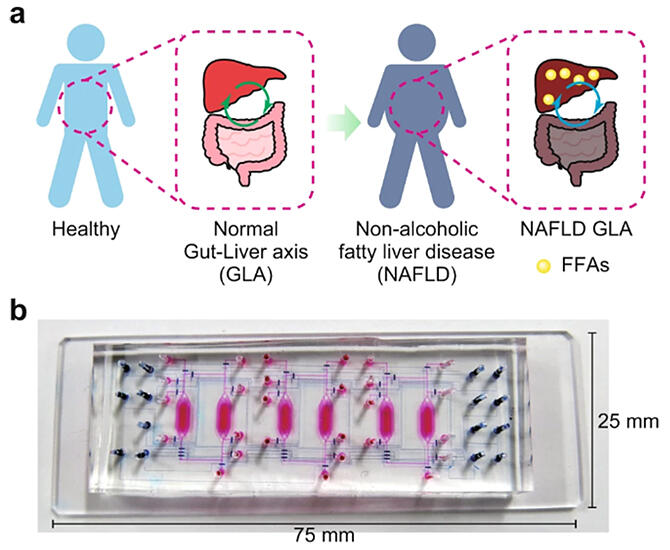The research group of Visiting Professor Ken‐ichiro Kamei of the Institute of Integrated Cell‐Material Sciences (iCeMS), Kyoto University, (also Associate Professor at New York University Abu Dhabi), Senior Lecturer Yoshikazu Hirai at the Engineering Education Research Center, Graduate School of Engineering, Kyoto University and Jiandong Yang of the Department of Micro Engineering, Graduate School of Engineering, Kyoto University, employing a micro‐flow path, has developed an in vitro gut‐liver‐connected organ chip that reproduces non‐alcoholic fatty liver disease (NAFLD), for which no effective therapeutic or diagnostic agents have been developed. The result is expected to lead to the determination of pathological conditions and the development of new therapeutic agents. The report was published in the journal Communications Biology.

(b) Photograph of an iGLC platform. The perfusion and control layers are colored in pink and blue, respectively.
Provided by Kyoto University
The number of patients is increasing worldwide. This chronic liver disease leads to liver steatosis, cirrhosis, cancer and cardiovascular disease. The only medical cure for severe symptoms is liver transplantation; however, donors remain very limited. NAFLD development involves complex processes, and the mechanism is poorly understood. Drug development for NAFLD requires a detailed understanding of each process.
Kamei and Hirai of Kyoto University have been working together to develop biological tissue chips. The integrated‐gut‐liver‐on‐a‐chip (iGLC) platform, a new organ chip that connects the intestines and liver, was developed through their collaboration.
The iGLC platform is equipped with micro‐valves and pumps within the chip that precisely control the flow of the cell culture medium; it allows both individual access to the cell culture chambers and the circular flow of the culture medium connecting the small intestine and liver cells.
Administration of free fatty acids (FFAs), an inductive factor of NAFLD, to the co‐culture of gut and liver cells on this platform reproduced cell states (such as intracellular lipid storage) corresponding to initial and progressive NAFLD. By combining mRNA sequencing and single‐cell profiling with microscopic imaging, they further examined the gene networks associated with unique changes in the cellular phenotype of an NAFLD state.
The researchers identified 654 genes (small intestinal cells) and 1,330 genes (liver cells) showing differences in gene expression under four conditions: with/without treatment with FFAs and monoculture/coculture. Coculture of small intestinal cells with liver cells reduced the regulation of gene expression by FFAs. In contrast to the conventional cell culture of individual culture, the new platform revealed that small intestinal and liver cells act with each other to protect against FFAs.
Kamei stated, "I am currently conducting joint research with a drug discovery company to determine what kind of pathology can be reproduced and to what extent. More efficient drug discovery will be achieved in preclinical and disease model studies without animal experiments."
This article has been translated by JST with permission from The Science News Ltd. (https://sci-news.co.jp/). Unauthorized reproduction of the article and photographs is prohibited.




